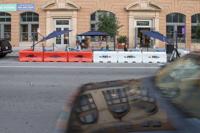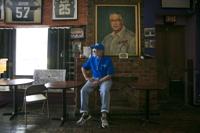First ‘parklets’ arrive in New Orleans, turning parking lanes into restaurant patios

PHOTO BY CHRIS GRANGER
Throughout the pandemic, restaurants have been transforming sidewalks, patios and parking lots to create new outdoor seating. Now, a handful of restaurants in downtown New Orleans are doing the same with the streets.
That includes the Pythian Market, which serves flavors from fried chicken to poke bowls from its various vendors. The food hall also has a new dining area built across the parking lane. It adds more outdoor seating and boosts visibility to potential customers.
It also offers a glimpse of what could soon be much more common around New Orleans.

PHOTO BY CHRIS GRANGER
Just outside the food hall’s doors, burly traffic barriers mark off the space where people now eat po-boys and wood-fired pizza under umbrellas and string lights — and between deactivated parking meters.
“We’ve seen how people gravitate to our sidewalk seating, and we think this will add to it,” said Michael DePaolo, managing director at Pythian Market. “We really want to provide an environment where people feel as safe as possible to come out and enjoy what our vendors are doing here.”
Crisis and change
Dubbed parklets in urban planning-speak, these new curbside patios are part of a raft of programs introduced by the city to help restaurants add more outdoor seating in the pandemic.
However, this particular tool also looks beyond the crisis. City officials call it a permanent new option for how New Orleans restaurants can operate outdoors.
When the idea was first unveiled, Jeff Schwartz, the city’s director of economic development, said the aim was to use the public right of way to help businesses immediately and also make the city’s framework for businesses more versatile and pedestrian-friendly.

Contributed photo from Ruby Slipper Cafe
Parklets essentially let restaurants take over parking lanes. The city vets specific areas for safety and appropriateness, and once approved it provides traffic barriers. Restaurants can add tables and dress up the newly designated dining area with lights, fans and other such amenities.
Already common in some cities, especially overseas, the parklet concept has become a symbol of creative adaptation during the pandemic.
In New Orleans, the effort is beginning in phases, starting in the Central Business District. Restaurants taking part in this first phase of the parklet program include Pythian Market at 234 Loyola Ave., the Juan’s Flying Burrito location at 515 Baronne St. and the Ruby Slipper Café location at 200 Magazine St., which all have them in place now, and Fourth Wall Coffee at 614 Gravier St., which should have a parklet in place soon.

Contributed photo from Ruby Slipper Cafe
Ruby Slipper co-founder Jennifer Weishaupt has seen parklets used successfully in other cities this summer, so she jumped at the chance to add one at her downtown location. As this pilot phase begins, she’s already looking ahead for how to add a parklet at another Ruby Slipper up the street in the Irish Channel.
“We’ve seen that there’s exceptionally high demand for outdoor seating. It’s where a lot of people feel most comfortable,” Weishaupt said.
Rethinking the ‘street scene’

PHOTO BY CHRIS GRANGER
Curbside dining areas also add vitality to the streets, and the parklets arrive at a critical time for downtown businesses struggling with the pandemic’s changes to work and travel patterns.
The Downtown Development District has been working with the city to launch the first parklets in the CBD, and loaning planter boxes, lights and other furnishings to restaurants taking part.
Kurt Weigle, president and CEO of the DDD, said the concept aligns with goals his agency has long been advocating.
“Sidewalk cafes are one of the ways we measure the success of downtown New Orleans,” said Weigle. “When you think about the great cities of the world, they’re places with outdoor dining. They’re a critical part of the street scene.”

PHOTO BY CHRIS GRANGER
Before Hurricane Katrina, there were only a handful of outdoor cafes across the entire downtown area. That dynamic has been changing as a historic hub of offices and industry has become a more densely populated and active center of the city.
David Williams, proprietor of Fourth Wall Coffee, has already seen the boost of adding more sidewalk seating during the pandemic, and he’s eager to expand it with a parklet.

PHOTO BY CHRIS GRANGER
“It’s honestly a lifeline for us,” Williams said. “When people know they can sit outside, it just draws them in. They see other people, they feel safe.”
He believes the city’s new embrace of outdoor options, and especially parklets, has great potential for downtown.

PHOTO BY CHRIS GRANGER
“Eight months ago the idea that the city would allow us to take over the parking lane felt like it was years off,” Williams said. “Now we have a chance to show that there’s a higher and better use of the space.”
Weigle said making parklets work is about “balancing interests,” including parking, foot traffic, bicycle transit and accessibility for people with disabilities.

PHOTO BY CHRIS GRANGER
“It all has to work in concert to keep people moving and have the creature comforts in these spaces to make people want to be there,” he said.
However, he believes the upside of working through these issues speaks to needs that have grown sharper since the pandemic.
“Even before COVID, you could feel the joy people get from being outdoors with friends in that kind of environment, and I think people are eager to reclaim that,” Weigle said. “We want to create new revenue streams for these businesses, but it’s also about some catharsis, psychologically and emotionally for us all, getting back to some of those things we value and miss.”





